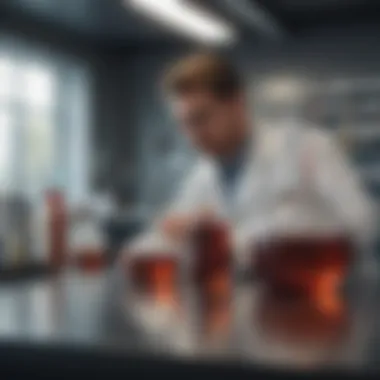Understanding Pure Hydrogen Peroxide: Properties and Uses


Intro
Hydrogen peroxide is a widely recognized chemical compound with a variety of applications in both laboratory and industrial settings. Understanding its properties, effects, and safe handling methods is crucial for its effective utilization. This article aims to provide a comprehensive exploration of pure hydrogen peroxide, including its chemical characteristics, common uses, safety guidelines, and environmental implications.
By analyzing its production processes and storage recommendations, this discussion will serve as an informative resource for students, researchers, educators, and industry professionals.
Key Findings
Major Results
The compilation of information surrounding hydrogen peroxide reveals several significant insights:
- Chemical Properties: Pure hydrogen peroxide is a clear, colorless liquid that serves as a powerful oxidizing agent. Its molecular formula is H₂O₂, reflecting its two hydrogen and two oxygen atoms.
- Applications: This chemical compound has diverse areas of application. It is used in disinfection, bleaching, and as a propellant in rocketry, among other functions.
- Safety Considerations: Proper handling techniques are essential, as hydrogen peroxide can be harmful at high concentrations. It can cause skin burns and respiratory issues if inhaled or contacted.
Discussion of Findings
The uses of hydrogen peroxide range from domestic products, like household cleaners, to vital roles in research labs focusing on material science and microbiology. The balancing act of leveraging its benefits while managing safety is crucial. For example, in the medical field, it is used as a disinfectant, underscoring its importance against pathogens. In environmental sectors, its use as an oxidizing agent assists with wastewater treatment. Each application warrants specific handling procedures to mitigate risks.
Methodology
Research Design
The examination of hydrogen peroxide utilizes a qualitative approach, combining analysis from scientific literature, case studies, and industry best practices. This design allows for a detailed understanding of not just the chemical itself, but how it is integrated into various fields.
Data Collection Methods
Data regarding hydrogen peroxide's properties, applications, and safety protocols was sourced from reputable articles, guidelines published by organizations such as the Environmental Protection Agency, and industry reports. These sources ensured a well-rounded perspective on both the advantages and potential hazards associated with pure hydrogen peroxide.
"Hydrogen peroxide is not merely a household item; it is a crucial component in various scientific and industrial applications."
The emphasis on safety protocols is vital, as the risks can escalate if proper measures are not adhered to. For instance, safety gear such as gloves and goggles should always be worn when handling pure hydrogen peroxide.
In summary, understanding pure hydrogen peroxide encompasses its versatile nature, safety concerns, and the methodologies underpinning its application across disciplines. The insights derived here aim to advance knowledge and ensure responsible usage in all settings.
Prelims to Hydrogen Peroxide
Hydrogen peroxide is a chemical compound that holds a significant role in various fields, including healthcare, industry, and household applications. It is more than just a simple antiseptic found in medicine cabinets; understanding its significance requires a deeper look into its properties, applications, and safety aspects. This article aims to provide an in-depth exploration of pure hydrogen peroxide, its composition, and value in both professional and everyday contexts.
Definition and Chemical Composition
Hydrogen peroxide, with the chemical formula H₂O₂, consists of two hydrogen atoms and two oxygen atoms. This unique structure results in a polar molecule, giving it potent oxidative properties. The presence of an extra oxygen atom distinguishes it from water, making it a powerful oxidizing agent. The concentration of hydrogen peroxide can vary greatly, from low concentrations typically used in household products to higher concentrations utilized for industrial applications. Its ability to act as both a disinfectant and an oxidizer makes it essential across multiple domains.
Historical Background
The history of hydrogen peroxide dates back to its first identification in 1818 by the French chemist Louis Jacques Thénard. Initially, it was a curiosity, but its usefulness was soon recognized. In the 19th century, hydrogen peroxide became a subject of study for its antiseptic properties. During World War I, it found new applications in medicine as a disinfectant for wounds. Over the decades, its use expanded into other fields such as textiles, paper, and even environmental applications for wastewater treatment. Today, hydrogen peroxide remains a vital chemical, with its versatility being a focal point of ongoing research.
"Understanding hydrogen peroxide is key to maximizing its potential across diverse applications while maintaining safety."
In summary, the introduction to hydrogen peroxide covers essential definitions and historical insights, establishing a foundation for understanding its multifaceted applications and implications in modern society.
Chemical Properties of Pure Hydrogen Peroxide
The chemical properties of pure hydrogen peroxide are critical in understanding its behavior in various applications and environments. These properties not only dictate how hydrogen peroxide can be used effectively but also inform its safety protocols and environmental impact. Knowledge of these characteristics helps researchers and professionals select appropriate concentrations for specific applications, assess potential risks, and enhance its efficacy as an oxidizing agent. Understanding these features can lead to more innovative uses and enhanced safety practices across different industries.


Molecular Structure and Characteristics
Pure hydrogen peroxide is represented by the chemical formula H₂O₂. It consists of two hydrogen atoms and two oxygen atoms. This simple molecular structure has unique properties. One notable characteristic is its ability to act as a strong oxidizing agent. This property is due to the presence of the peroxy bond (–O–O–), which makes it relatively unstable compared to common substances like water.
The bond between the oxygen atoms is less stable than typical oxygen bonds. This instability allows hydrogen peroxide to generate reactive species, such as hydroxyl radicals, that can react with a variety of other compounds. This property is invaluable in many processes, including disinfection, bleaching, and even in some chemical syntheses.
Concentration and Dilution
Hydrogen peroxide is available in various concentrations, commonly ranging from 3% for household use to upwards of 30% or more for industrial applications. The concentration affects its reactivity, stability, and suitable use cases. A higher concentration signifies increased potential for oxidation, but also greater risks associated with handling and storage.
Key Considerations:
- High Concentration Risks: Higher concentrations can cause severe burns on contact. Proper storage and handling procedures must be enforced.
- Dilution Benefits: In many applications, such as disinfection in health care or cleaning processes in households, diluting hydrogen peroxide to around 3% is practical and safe. This concentration still provides antimicrobial properties without high risk.
- Application Specificity: Different concentrations serve different purposes. Therefore, understanding what concentration to use in a particular scenario is crucial to maximizing effectiveness while ensuring safety.
"The efficient use of hydrogen peroxide hinges upon understanding its concentration and molecular characteristics."
In summary, the chemical properties of pure hydrogen peroxide—its molecular structure and the implications of concentration—play a significant role in determining how this chemical can be applied safely and effectively in various contexts. This knowledge is essential not only for potential users but also for scientists engaged in research and development.
Production and Synthesis Methods
Understanding the methods for producing and synthesizing pure hydrogen peroxide is crucial for comprehending its various applications and benefits. These methods not only influence the purity of the compound but also determine its availability and efficiency in different applications. Factors such as cost and environmental impact play a significant role in selecting a production method. In industrial and laboratory settings, the synthesis process can have implications on safety protocols and operational efficiency. Thus, grasping these intricate aspects is essential for anyone working with or researching hydrogen peroxide.
Industrial Production Methods
The industrial production of hydrogen peroxide primarily relies on two methods: the anthraquinone process and the electrolysis method.
- Anthraquinone Process: This is the most widely used method. It involves the oxidation of anthraquinone to form peracid, which then leads to the production of hydrogen peroxide. The reaction is efficient and can be scaled to meet large demands. The process allows for high-purity hydrogen peroxide generation, making it suitable for pharmaceutical and textile applications.
- Electrolysis Process: This method uses electric current to produce hydrogen peroxide directly from water. While it is attractive for its simplicity and ability to produce on-site, it often yields lower concentrations compared to the anthraquinone method. Moreover, the electrolysis process can have higher operational costs due to energy consumption.
These industrial methods help in meeting the global demands for hydrogen peroxide which spans from medical uses to bleaching and water treatment industries.
Laboratory Synthesis Techniques
In laboratory settings, synthesizing hydrogen peroxide can be achieved through various techniques tailored for small-scale production.
- Laberatory Method: One common technique is the reaction of barium peroxide with sulfuric acid. This is a simple process where the barium compounds react to produce hydrogen peroxide and barium sulfate as a byproduct, which can be filtered out easily. The advantage is that this reaction is relatively easy to conduct and provides sufficient yields for laboratory experiments.
- Homemade Synthesis: Some researchers have explored home-based methods as a way to produce small amounts of hydrogen peroxide for educational purposes. These typically involve safer, common chemicals, although this can lead to varying purity levels.
The laboratory methods offer insights into hydrogen peroxide’s properties and help educators demonstrate chemical reactions effectively. However, safety is paramount, as proper precautions must be taken to handle the toxic and potentially hazardous byproducts.
"Regardless of the production method, maintaining high purity levels of hydrogen peroxide is critical for ensuring its effectiveness and safety in any application."
Applications of Pure Hydrogen Peroxide
The applications of pure hydrogen peroxide are diverse and significant across many sectors. It is versatile due to its properties as a strong oxidizer and its ability to decompose into water and oxygen, making it relatively safe compared to other chemicals in certain uses. Understanding these applications allows both professionals and researchers to leverage hydrogen peroxide effectively, enhancing both operational efficiency and safety protocols. The importance of this segment lies in its relevance to healthcare, industrial manufacturing, and everyday household needs.
Medical Applications
Pure hydrogen peroxide is utilized in several medical contexts. It serves as a disinfectant for minor cuts and abrasions. Its oxidizing properties aid in killing bacteria, viruses, and fungi, making it crucial in clinical settings. This chemical is often diluted to 3% concentrations or less for safe use on human skin.
In addition to disinfection, hydrogen peroxide plays a role in oral care. Dentists sometimes employ it as a whitener in teeth bleaching products. Its ability to break down stains on enamel makes it a valuable ingredient in dental hygiene. Care must be taken since its misuse can lead to irritation or damage.
"Due to its reactive nature, hydrogen peroxide should be applied with caution, especially in concentrations above 10%."
Industrial Uses


In industrial environments, pure hydrogen peroxide finds numerous applications. Its primary use is in the pulp and paper industry, where it bleaches wood fibers. This process is environmental-friendly, as it avoids the use of chlorine-based bleaches that can release hazardous compounds.
Moreover, hydrogen peroxide is employed in textile processing and as a powerful cleaning agent in various manufacturing processes. It serves effectively in disinfection of surfaces in food processing. In this setting, it maintains hygienic conditions without leaving toxic residues, making it ideal for food contact surfaces.
Industries also utilize hydrogen peroxide as a propellant in rocket technology. Its efficiency as an oxidizer offers advantages in space missions, providing thrust when combined with various fuels.
Household Applications
For household use, hydrogen peroxide is a common ingredient in many cleaning products. It acts as a mild bleach and is effective in removing stains from clothing, carpets, and other fabrics when used appropriately. The non-toxic nature at lower concentrations makes it appealing for families seeking safer cleaning alternatives.
In addition to cleaning, hydrogen peroxide is frequently used for disinfecting surfaces in kitchens and bathrooms. It can effectively kill germs, making homes safer from illnesses. It’s often found in solutions for sanitizing cutting boards or countertops.
Household gardening applications also exist. Hydrogen peroxide can be used to promote plant growth by increasing oxygenation in soil. It helps prevent root rot and fungal infections when diluted correctly.
The multitude of applications showcases the versatility of pure hydrogen peroxide, highlighting its importance across various fields. By understanding these applications, stakeholders can harness this chemical’s potential while remaining cognizant of the safety and environmental considerations essential to its use.
Safety Considerations
Safety considerations associated with pure hydrogen peroxide are critical for both its handling and application across various fields. Given its powerful oxidizing properties, improper use or neglecting safety protocols can cause adverse effects, including severe health risks and environmental hazards. Understanding these risks is essential for anyone working with this compound, whether in medical, industrial, or laboratory settings. By focusing on key elements such as handling and storage guidelines, as well as its toxic and hazardous nature, one can ensure a safe working environment.
Handling and Storage Guidelines
When handling pure hydrogen peroxide, several precautions must be observed to mitigate risks:
- Personal Protective Equipment (PPE): Always wear appropriate PPE, including gloves, goggles, and lab coats. This lowers the risk of skin and eye contact.
- Ventilated Areas: Always use hydrogen peroxide in well-ventilated areas. Adequate airflow reduces inhalation risks.
- Avoid Contamination: Keep the substance away from organic materials, metals, and any flammable agents. Contamination may lead to explosive reactions.
For storage, adhering to specific guidelines is equally vital:
- Temperature Control: Store hydrogen peroxide in a cool, dark place. Higher temperatures can accelerate decomposition.
- Container Integrity: Use original containers or compatible materials to avoid reactions. Glass containers with UV protection are preferred.
- Labeling: Clearly label all containers to prevent mix-up and ensure proper information is available at all times.
Following these handling and storage protocols plays a major role in minimizing risks associated with hydrogen peroxide.
Toxicity and Hazardous Nature
Hydrogen peroxide is classified as hazardous. Its toxicity is influenced by concentration levels; higher concentrations present significant risks. Key factors include:
- Skin and Eye Irritation: Concentrated hydrogen peroxide can cause severe burns upon contact. It is essential to follow first-aid protocols instantly if exposure occurs.
- Inhalation Risks: Inhalation of vapors can lead to respiratory issues. Symptoms may include throat irritation or difficulty breathing.
- Environmental Impact: In large amounts, hydrogen peroxide can negatively affect aquatic life. Proper disposal methods are crucial to avoid contamination of water systems.
To understand the precise nature of hazards, reference Material Safety Data Sheets (MSDS) and safety protocols on handling hydrogen peroxide.
Environmental Impact
The discussion of pure hydrogen peroxide necessitates an examination of its environmental impact. Understanding this aspect is crucial, as it informs users about its interaction with ecological systems and promotes responsible application. Hydrogen peroxide is often seen as a green alternative to harsher chemicals used in various sectors. Its breakdown products are primarily water and oxygen, which means that its use can be less harmful to the environment compared to more persistent pollutants.
Biodegradability and Ecotoxicology
One of the significant advantages of pure hydrogen peroxide is its biodegradability. When released into the environment, it rapidly decomposes into water and oxygen, posing little long-term threat to ecosystems. This decomposition happens through photolytic and microbiological processes. However, in high concentrations, hydrogen peroxide can be toxic to aquatic life. Care must be taken to manage concentrations in industrial discharges to minimize potential harm.
Some studies indicate that while low concentrations do not affect most organisms, higher levels can disrupt marine ecosystems, resulting in decreased species diversity. For instance, fish and invertebrates show a range of sensitivity to hydrogen peroxide, which suggests that close monitoring is needed in areas susceptible to accidental spills or incorrect usages. Furthermore, stressing the importance of responsible handling and disposal methods cannot be overstated.
Regulatory Considerations
As hydrogen peroxide is widely used across various industries, regulatory bodies have set guidelines on its usage to safeguard environmental health. Several organizations, including the Environmental Protection Agency (EPA) in the United States, provide regulations that govern the allowable concentrations of hydrogen peroxide in waste streams and its application in agricultural settings.


Key regulatory considerations include:
- Permissible Concentration Levels: Agencies often specify limits on the maximum allowable concentrations that can be released into natural water bodies. These limits ensure that biological organisms are not adversely affected.
- Labeling Requirements: Products containing hydrogen peroxide typically come with safety data sheets (SDS) that detail the potential environmental hazards associated with its use. Stakeholders must adhere to these labeling requirements to ensure proper training and use.
- Environmental Impact Assessments (EIAs): Projects involving large quantities of hydrogen peroxide may require an EIA to evaluate potential negative impacts on local ecosystems and biodiversity.
Comparative Analysis with Other Oxidizing Agents
The comparative analysis of hydrogen peroxide with other oxidizing agents is crucial for understanding its role in various applications. This analysis reveals not only the strengths of hydrogen peroxide but also sheds light on the scenarios where it may not be the ideal choice. Evaluating different oxidizing agents such as sodium hypochlorite, potassium permanganate, and chlorine provides insights into selection criteria based on efficiency, safety, and cost.
Efficiency in Various Applications
When comparing the efficiency of hydrogen peroxide with other oxidizing agents, the specific application often dictates the most suitable choice. Hydrogen peroxide is favored in many scenarios due to its strong oxidative properties and relatively benign end-products. For instance, in the realm of water treatment, hydrogen peroxide is effective at breaking down organic pollutants, whereas sodium hypochlorite might also introduce harmful by-products.
- Water Treatment: Hydrogen peroxide is employed to remove contaminants and disinfection, often performing better than chlorine-based agents in terms of residual toxicity.
- Textile Industry: In bleaching processes, hydrogen peroxide provides effective results with lower environmental impact compared to chlorine bleaching agents. It serves to brighten fabrics while maintaining their integrity.
- Food Industry: Hydrogen peroxide is employed as a sanitizer for food processing equipment, highlighting its safer profile compared to some traditional chemical sanitizers.
In these examples, hydrogen peroxide stands out for its efficacy in achieving desired outcomes while minimizing negative ecological effects.
Cost-Effectiveness
Assessing the cost-effectiveness of hydrogen peroxide relative to other oxidizing agents entails not only the initial purchase price but also the entire lifecycle cost, including safety measures and disposal requirements. Hydrogen peroxide often appears more favorable when one considers the broad spectrum of applications and its relatively low environmental footprint.
A few relevant points about cost-effectiveness include:
- Purchasing Price: Hydrogen peroxide is generally competitively priced, although specific concentrations and purity can affect costs.
- Operational Efficiencies: Due to its effectiveness in lower concentrations, hydrogen peroxide may reduce the need for additional treatments or processes, ultimately saving costs.
- Regulatory Compliance: Using hydrogen peroxide may simplify regulatory compliance requirements in certain industries due to its less hazardous profile compared to other agents like chlorine, which often requires more stringent handling procedures.
"The choice of an oxidizing agent should align with both the desired application outcomes and the commitment to environmental safety and efficiency."
Understanding the nuances of these comparisons helps professionals make informed decisions tailored to their respective fields.
Future Trends and Innovations
As we look towards the future, understanding the trends and innovations in the field of pure hydrogen peroxide is crucial. This section outlines key advancements and research areas that promise to redefine applications and enhance safety measures surrounding this versatile chemical. Moreover, recognizing these developments helps various stakeholders, including researchers, educators, and industry professionals, to align with emerging best practices and new technologies. The synergy between environmental considerations and technological innovation will undoubtedly shape future uses of hydrogen peroxide.
Emerging Research Areas
Recent research initiatives have begun to delve into innovative uses and properties of pure hydrogen peroxide, broadening its applications beyond traditional boundaries. One significant focus is on its role in green chemistry. Researchers are exploring hydrogen peroxide as a more environmentally friendly oxidizing agent, aiming to mitigate the environmental impact associated with more harmful chemicals. This aligns with a global emphasis on sustainable practices.
Another intriguing area is the study of hydrogen peroxide in addressing microbial resistance. As antibiotic resistance becomes an increasing concern, hydrogen peroxide shows potential as an antimicrobial agent in both clinical and agricultural settings. Its effectiveness against a broad spectrum of pathogens makes it a candidate worth examining further. The importance of such research cannot be understated as the quest for solutions to healthcare and agricultural challenges intensifies.
Technological Advances in Production
Technological strides in the production of hydrogen peroxide are pivotal for enhancing its availability and reducing costs. Traditional methods, although effective, often result in significant by-products that are undesirable. New production techniques, such as the anthraquinone process, are being refined to improve yield and efficiency. Innovations in membrane technology are also on the rise, showcasing the ability to produce hydrogen peroxide directly from hydrogen and oxygen while minimizing environmental waste.
Furthermore, advancements in automated production systems contribute to achieving higher purity levels of hydrogen peroxide. Automation not only fosters precision but also ensures better safety during production. Companies that invest in these technologies can expect benefits such as reduced operational costs and improved quality control. As these methods become more established and cost-effective, they will likely lead to widespread adoption in industrial applications and beyond.
The convergence of emerging research and technological innovation places hydrogen peroxide at the forefront of sustainable and efficient chemical practices.
By keeping an eye on these evolving trends, professionals in related fields can better prepare for the shifts in the market, aligning their practices with the most current and effective methodologies.
Finale
The conclusion serves as a vital component of this article. It encapsulates the critical insights gleaned from an extensive exploration of hydrogen peroxide. Understanding this compound lies not only in its diverse applications and properties but also in its implications for safety and environmental concerns.
Specific elements to highlight in the conclusion include:
- Diverse Applications: Hydrogen peroxide finds usage in medical, industrial, and household settings. Its versatility underscores its significance in various sectors.
- Safety Protocols: The necessity of adhering to safety protocols cannot be overstated. Proper handling and storage are crucial to preventing accidents and ensuring safe use.
- Environmental Considerations: This chemical's biodegradability enhances its appeal as an eco-friendly option compared to other substances. Awareness of its environmental impact is essential for responsible usage.
Benefits of Understanding Hydrogen Peroxide:
- By grasping its properties and uses, readers can make informed decisions about its application.
- Knowledge of safety measures ensures risks are minimized in practical settings.
- Comprehending the environmental effects aids in aligning with sustainable practices.
In summary, the conclusion synthesizes the themes presented in the article. It reinforces the importance of hydrogen peroxide as a significant chemical compound in modern society. This piece serves as a foundational resource for students, researchers, and professionals seeking deeper insight into the myriad facets of pure hydrogen peroxide.



